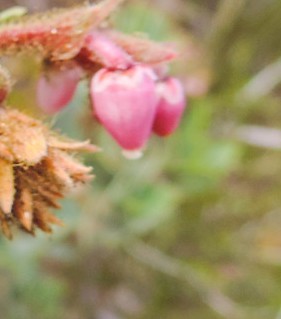Parry manzanita
(Arctostaphylos parryana)

Description
Arctostaphylos parryana, with the common name Parry manzanita, is a species of manzanita. Arctostaphylos parryana is an erect manzanita, standing on red-barked stems and reaching up to two meters in height. The leaves are bright green, generally oval in shape and pointed. The small pink-tinted white flowers are borne in densely bunched inflorescences. The fruit is a rounded drupe which contains two or more seeds which have fused into one body. The fruit was a food of the Luiseño of Southern California. This shrub is endemic to California, where it grows in the western section of the Transverse Ranges, from coastal Santa Barbara County to the San Gabriel Mountains. This is a manzanita of chaparral and low-elevation coniferous forest ecosystems. Arctostaphylos is a genus of plants comprising the manzanitas and bearberries. They are shrubs or small trees. There are about 60 species, of Arctostaphylos, ranging from ground-hugging arctic, coastal, and mountain species to small trees up to 6 m tall. Most are evergreen (one species deciduous), with small oval leaves 1–7 cm long, arranged spirally on the stems. The flowers are bell-shaped, white or pale pink, and borne in small clusters of 2–20 together; flowering is in the spring. The fruit are small berries, ripening in the summer or autumn. The berries of some species are edible. Arctostaphylos species are used as food plants by the larvae of some Lepidoptera species including Coleophora arctostaphyli (which feeds exclusively on A. uva-ursi) and Coleophora glaucella. Manzanitas, the bulk of Arctostaphylos species, are present in the chaparral biome of western North America, where they occur from southern British Columbia in Canada, Washington to California and New Mexico in the United States, and throughout much of northern and central Mexico. Three species, the bearberries, A. alpina (alpine bearberry), A. rubra (red bearberry) and A. uva-ursi (common bearberry), have adapted to arctic and subarctic climates, and have a circumpolar distribution in northern North America, Asia and Europe. An unusual association of manzanita occurs on Hood Mountain, in Sonoma County, California, where stands of pygmy forest dominated by Mendocino cypress are found.
Taxonomic tree:







